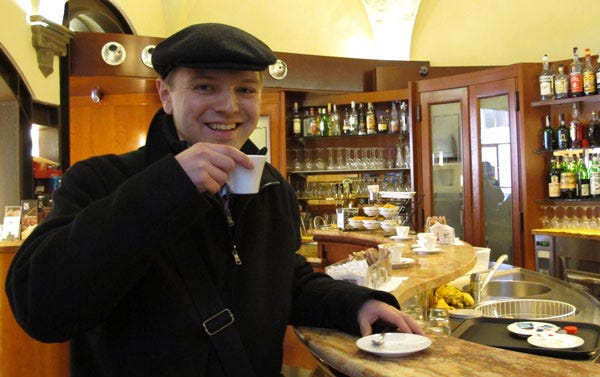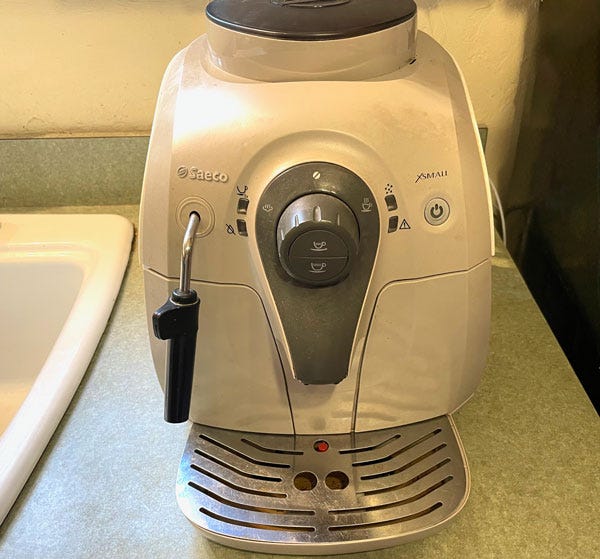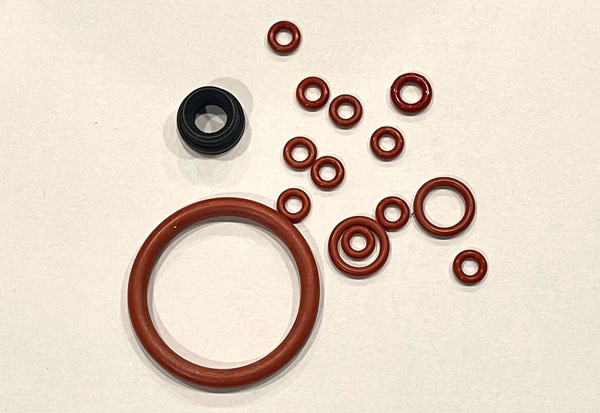Wednesday Walk: Fresh Espresso
Repairing an espresso machine is hard, new pricing for groceries, and the Brady house sells
Welcome to Willoughby Hills!
If you enjoy what you’re reading, please consider a free subscribtion to receive emails every Wednesday and Sunday plus podcast episodes every two weeks. There are also paid options, which unlock even more features.
As is typical every Wednesday, I’m bring you a smattering of topics that I hope will make you a bit more curious about the world around you and give you something to think about later. I call these Wednesday Walks, as it’s the type of conversation we might have walking down a path in the woods. Shall we take a stroll?
Wrong to Repair?
Ever since I interviewed Sandra Goldmark on the podcast about the challenges of repairing the stuff in our lives, I’ve been more consciously trying to embrace repairing over replacing. It’s taken a mentality shift on my part and a concerted effort. Even with instant access to products and service videos online, it can still be really difficult to solve a problem.
I’ve written before about how visiting Costa Rica made me fall in love with sustainable coffee served black. But after visiting Europe, I became a sucker for espresso. In Italy in particular, there’s an entire cafe culture built around espresso. I love the simplicity of their system, where you walk up to a coffee bar, are served a shot of espresso in a ceramic cup, drink it at the bar, and pay with a single Euro coin (or at least that was the case a decade ago- perhaps inflation has come to the coffee counter too).
I was thrilled about 8 years ago when I found a an affordable automatic espresso machine at Costco that took fresh whole beans, ground them on demand, and then spit out an espresso shot. It also had a steam wand for frothing milk for cappuccinos and lattes. It was made by Saeco, which is a European brand owned by Philips, but was designed for the American market with a 120 volt plug. It was just over $300, which was a splurge for a coffee machine, but the only midrange espresso machine I could find with those features (most espresso machines are higher end, running several thousand dollars).
I don’t know that there’s been a day that’s gone by in the last 8 years where I’ve been at home and haven’t used that coffee machine. It’s a beast, and it still puts out really good coffee. But one day last month, it began to leak and no longer was making coffee.
For most people, a leaky coffee machine would warrant searching for an equivalent model brand new. But I felt like I could fix it, or at least I wanted to. The few YouTube videos I watched didn’t seem to address my problem, nor were they helpful enough for me to find a solution.
But they gave me enough confidence to take the unit apart and explore. When I did that, I discovered a worn rubber o-ring. I know from the plumbing world that o-rings work like a gasket, forming a water tight seal. This once was pretty shredded, and my guess was that the faulty o-ring was what was causing my leak.
The site I found for Saeco seemed to cater to European customers, and Amazon only had parts shipments with long lead times.
A Google search also showed parts available, but from generic sounding websites that I couldn’t verify the legitimacy of, all seemingly based overseas. Google also alerted me to several products selling on eBay brand new that seemed to do the trick, but also from overseas sellers.
I ultimately decided to purchase through eBay because I felt I would have some recourse if the item never arrived or was not what was described, a protection I might not have ordering directly from a random website. The item, a package of various Saeco o-rings, was shipping from Bulgaria.
The new o-rings arrived this week in a nondescript envelope. The return address listed a company in Portland, OR, whereas the USPS tracking information began in New Jersey. There was no customs declaration or any sign that this envelope had come from Europe.
The o-ring took about one minute to swap out and my espresso machine was suddenly as good as new. I paid $15 for the kit of o-rings and it saved my $300 coffee maker!
Here’s the thing, though. While I was proud of my confidence to roll up my sleeves, dig around inside, find the problem, and then hunt down an international solution, I realize that I’m not the norm. Most people wouldn’t begin to know how to take apart a coffee machine and probably wouldn’t know what they were looking at once inside. I barely understood what I was looking at, but I understood from my This Old House days that an o-ring helps create a watertight seal and a shredded one is not good.
YouTube and other online resources are a vast treasure trove of information, but they can’t be designed to address every situation or problem. Going through the exercise of attempting to repair a coffee machine made me more aware of the need for practical, hands-on education at a young age for all students, not just those deemed to be in the trades or working as a mechanic. There’s knowledge in all of our hands, but it takes time to learn how to speak the language of our hands and to understand how to harness that power. Teaching basic repair skills in school (or other practical arts like sewing, cooking, and woodworking) helps us develop our tactile skills which can lead to greater self sufficiency and help curb consumerism and waste.
(Side note: if you’ve listened to the podcast with Sandra, you heard me describe fixing a coffee machine. That was actually my pod-based Nespresso machine which I used to keep in my office and is now in our RV. If you’re keeping count, I own two espresso machines and both required repair this summer. Let’s hope it was just a strange coincidence.)
How Much Does This Cost?
Earlier this week, Katie Rodriguez published an interesting piece for Civil Eats about how bringing dynamic pricing to supermarkets could help lower food waste.
If the term dynamic pricing isn’t familiar, the concept certainly is. It means that pricing can shift based on perceived supply and demand and it’s a model used for airline tickets, hotel rooms, and more.
We encountered dynamic pricing at Walt Disney World this summer, where each park may have a different daily admission price (the less popular Animal Kingdom park is almost always less expensive than the frequently visited Magic Kingdom), and those prices vary by day of the week and time of the year. Late September weekday tickets are significantly cheaper than a summer weekend, for example.
Rodriguez points to a new study from U.C. San Diego’s Rady School of Management that shows how dynamic pricing would work in a supermarket setting:
“Robert Sanders, the study’s author, used economic models to show that if grocery retailers used dynamic pricing to adjust prices for perishable foods based on how long they’ve been on the shelves, retailers would likely dramatically curb food waste.
Sanders says this isn’t to be confused with simple last-minute clearance sales. ‘It’s gradual discounts throughout the shelf life of the product,’ he adds. ‘You don’t do discounts just at the end of the last day. The price is changing throughout the [time] horizon.’”
As it’s described, the newly stocked items would be the most expensive (as they are presumed to be freshest), with older items gradually following some kind of sliding scale.

This reminded me a bit of the automatic markdown system that was in place at the now defunct Filene’s Basement store in Boston’s Downtown Crossing (a retail hub which I wrote about here). At that store, every item was tagged with a date and a price. Initially, items were priced as marked, but after a certain amount of time, the item would be discounted by 25%. If it still didn’t sell, it would be marked down to 50% off the tagged price, and then 75%.
Of course, marking down singular items of clothing and marking down food are two different propositions. As Rodriguez points out in her piece, grocers like to present as selling fresh food and may not like the perception of having merchandise on the cusp of expiring (even though that’s the reality at many stores, especially with perishables).
To combat that, there are lots of food retailers that sell surplus grocery items that cannot be sold by more conventional grocers or suppliers. There’s an interesting new retailer in Massachusetts founded by a former Trader Joes executive called Daily Table, which is stocked entirely with grocery overstock. I visited the one in Roxbury, MA earlier this summer and it felt like a bare bones Trader Joes, sans the Hawaiian shirts, murals, and ringing bells.
I’ve mentioned it before, but Jesse Hirsch also writes a great newsletter called The Haul which showcases the food he and his fiancé buy from a salvage grocer in New York City.
But in both cases, these are separate locations that may be sourcing food from major grocers, but are not affiliated directly with the mainline store and it still involves trucking items between locations. I also imagine that dynamic pricing is more attractive for perishables like milk and produce rather than dry goods that are more shelf stable.
I could imagine if technology like the Whole Foods Dash Carts that I profiled a few months ago become more widespread, they could lead to a more personalized shopping experience that accounts for dynamic pricing.
It could be an interesting way to diversify a customer base. A store like Whole Foods Market, which has a reputation for being higher end, could potentially attract a more budget conscious consumer that is more willing to purchase something at a deal and use it quickly.
The notion of one banana costing 25¢ and another costing 10¢ is novel and I thought was worth exploring a bit and sharing with all of you, even if I don’t fully understand the logistics of how it would happen yet.
New Bradys on the Block
Finally this week, just a quick update on the fate of The Brady Bunch house in Los Angeles. I interviewed Maureen McCormick on the podcast after she and the other Brady cast members starred in HGTV’s A Very Brady Renovation. The show took the house that was originally used for exterior shots on the 1970s series and made the inside more closely resemble the show’s sets.
HGTV had originally outbid NSync band member Lance Bass for the house in 2018, but their plans for the house were unknown at the time. I envisioned a quick and tacky renovation that might have evoked the 1970s but was pretty surface level. Boy was I wrong.
HGTV went all out, taking a split level home that in no way resembled the soundstage sets inside and somehow perfectly recreating the house we remember from TV. They did so with an all star cast of HGTV talent and with the help of all 6 original Brady kids. It was a star studded event and was good television.
HGTV continued to use the house for specials and events, but the house was recently placed on the market and was sold at a loss. The home was purchased in 2018 for $3.5 million and sold for $3.2 million (HGTV also spent about $2 million in renovation costs, which I’m assuming does not account for the production costs of the series).
Side note: where else but Southern California would $3 million be considered a reasonable price for a basic split level home?! $3 million in New England is a mansion with a pool and a few acres. But I digress…
According to The Wrap, the new owner is Tina Trahan, wife of former HBO chief executive Chris Albrech. She seems to appreciate the house for what it is:
“‘It’s almost like a life-size dollhouse,’ Trahan said. ‘Nobody is going to live in it. No one is going in there to make pork chops and applesauce in that kitchen. Anything you might do to make the house livable would take away from what I consider artwork.’”
I hope that the home is available for tours or other public events at some point as I would love to see the inside of it. I’m also glad it was sold to somebody who seems to understand the value in it.
I publish new issues every Wednesday and Sunday. Sign up to always receive the latest issue and support my work:
Other Wednesday Walks
If you’ve missed past issues of this newsletter, they are available to read here.












